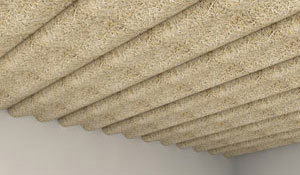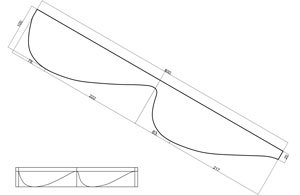Anne Stensgaard
Can you redesign traditional cement-bonded wood wool panels to give them a more aesthetic expression – without compromising their good acoustic properties?
This was the challenge Anne Stensgaard took up in cooperation with Troldtekt.

Can you redesign traditional cement-bonded wood wool panels to give them a more aesthetic expression – without compromising their good acoustic properties?
This was the challenge Anne Stensgaard took up in cooperation with Troldtekt.
Anne Stensgaard is a trained glass-blower and therefore has an eye for shapes. She is passionate about quality products made from natural materials – especially if they have a wide appeal. She also has an ear for good acoustics. It was therefore an obvious choice for her to do her design and technology project in cooperation with Troldtekt.
“I wanted to explore what could be done with Troldtekt panels in terms of shape. The main issue was how to achieve aesthetic expression using industrial acoustic panels,” explains Anne Stensgaard.
The production process took two months and she received assistance from several of Troldtekt's employees along the way. Kurt Madsen from the head office helped define the material's capabilities and the direction for the project. Anne Stensgaard also worked extensively with the production manager and a carpenter, who provided feedback and help with practical execution and installation at the workshop in Troldhede.
Beautiful shapes
For her final project, Anne Stensgaard presented panels pressed into concave arches, double waves and other enticing curved shapes. She received a positive response.
“The project was very successful. The panels have a more sensory expression and the structure is beautifully highlighted by the new shapes – without detracting from the material strength. The acoustic effect is actually improved by the shape of the panels and the direct integration of the diffusers into the cement-bonded wood wool,” she explains.
Positive opportunities
The new panels are aimed at the private market, prominent commercial buildings and public construction projects – and have been enthusiastically received by Troldtekt.
“It is natural for us to help ambitious students, and we value the dynamism and development opportunities the project has given us,” says Peer Leth, CEO.
The organic shapes are now on display in the company's showroom, where they are waiting for the right project to kickstart production.
The three series
In addition to her work with the new organic shapes, Anne Stensgaard also developed a series of panels using standard Troldtekt panels which were simply cut into various shapes. She designed three different series, which Troldtekt can now produce to order.

Troldtekt small circles
Troldtekt small circles: panels are cut to the desired dimensions and then holes are cut in the panels. The panels are installed in two layers, using contrast colours. Either two layers of cement-bonded wood wool or a layer of Rockfon with a coloured felt layer and a layer of cement-bonded wood wool.

Troldtekt indent
Troldtekt indent: panels of various thicknesses which create different levels of indentation. The panels are installed like standard Troldtekt panels, but using different screws depending on the panel thickness.

Troldtekt circles
Troldtekt circles: panels are cut to the desired dimensions and then holes are cut in the panels. The panels are installed in two layers, using contrast colours. Either two layers of cement-bonded wood wool or a layer of Rockfon with a coloured felt layer and a layer of cement-bonded wood wool.
Sketches & ideas
Anne Stensgaard's aim with the project was to present new ideas for products which add sculptural and aesthetic value to a room. She also wanted to develop products which did not compromise on acoustics and were affordable.
Anne Stensgaard wrote in her project report that she had two choices – to conceal the acoustic dampening, or to highlight it as part of the interior design. She decided on the latter approach, as she wanted to develop products that make a visual difference and add architectural value to the room.
Anne Stensgaard drew inspiration from current home and interior design trends. She wrote in her project report that current trends point to a softer and more personal interior design, as well as a more expressive and bold style. Organic shapes are also being commonly seen on walls and ceilings. Anne Stensgaard had three proposals:
1. 3D surface
- Make the surface of the modules three-dimensional.
- Work with the surface to give it an organic, living expression.
- Incorporate sound diffusers/barriers directly into the panels.
- Exploit the lighting and shadow effects resulting from the shape.
- Tint the cement in new colours.
2. New surface structures
- Work with the surface.
- Decorate using various light materials in the surface: bamboo fibre, textiles, knits, aligned wood shavings, plaited bands, etc.
- Increase the surface strength.
3. Cut panels in geometric shapes
- Cut 600x2000 mm panels in new geometric shapes.
- Tint the cement in various new colours.
- Install the panels in mosaic patterns in various combinations.
- Use the modules for decoration on large surfaces.
- Curved surfaces are also possible.
3D shapes
According to Anne Stensgaard, the new 3D shapes for the cement-bonded wood wool panels were the most interesting outcome of the project. The 3D shapes have the extra advantage that you can incorporate barriers directly into the panels and hopefully achieve the same effect as if you installed slats or a similar ceiling.
The organic shapes will diffuse the sound directly. The 3D designs appeal to our senses and help create atmosphere and make a stringent room more inviting.
Anne Stensgaard chose to continue to use wood for the surface structure. She considered using the wood shavings in a more organised and structured way, to see how the expression of the panels would change if all the fibres were aligned in the same direction or woven together. However, this was impractical, and the new shapes gave the wood an attractive appearance without requiring a change in structure to achieve a more organic and aesthetic look.
Sketches & ideas: Simple wave
This shape begins with a 30 mm straight section, making it possible to install the modules using screws, and giving the wave a more pronounced curve. The modules can be installed in various combinations.
Installation: 4 screws, T35 profile or concealed KN bracket.
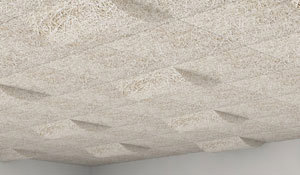
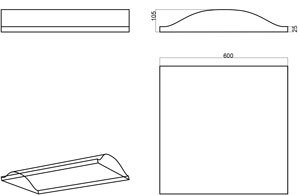
Sketches & ideas: Concave curve
These curves are the ideal choice when renovating old livestock buildings. The curved arches will provide associations with the traditional vaulted ceilings.
Installation: T35 profile or concealed KN bracket.
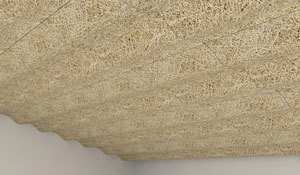
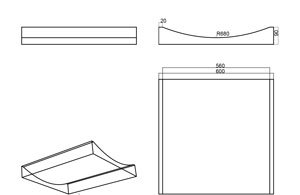
Sketches & ideas: Asymmetric wave
Modules can be used to cover the entire ceiling or installed as individual modules between standard 600 x 600 mm panels.
Installation: Concealed T35 profile or KN bracket.
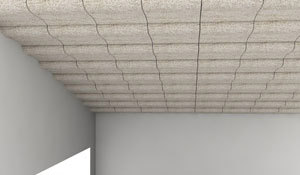
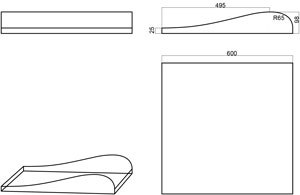
Sketches & ideas: Double wave
This module begins with a 30 mm straight section, making it possible to install the modules using screws, and giving the waves more pronounced curves.
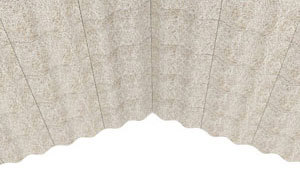
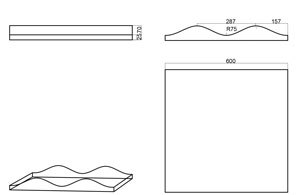
Sketches & ideas: Double asymmetric
These modules look great when used to cover an entire ceiling. The light will produce varying shadows depending on the direction, and the waves have a more subtle or pronounced effect depending on the angle they are viewed from.
Installation: concealed KN bracket or T35 profile.
